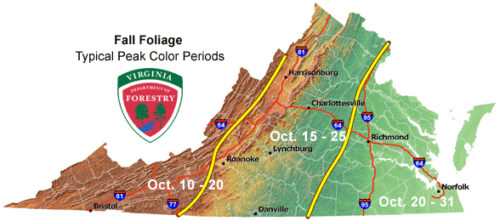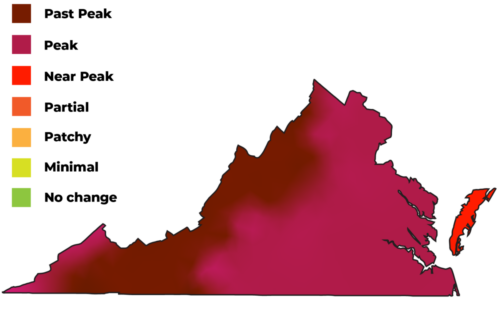 Virginia is diverse in landscape, from the highest mountains to the Eastern Shore. The variety in landscape and elevation provides a long fall foliage season, starting earliest in the higher elevations and moving eastward. Fall colors generally peak sometime between October 10 and October 31; however, these dates can vary from year to year, based on factors such as temperature and rainfall.
Virginia is diverse in landscape, from the highest mountains to the Eastern Shore. The variety in landscape and elevation provides a long fall foliage season, starting earliest in the higher elevations and moving eastward. Fall colors generally peak sometime between October 10 and October 31; however, these dates can vary from year to year, based on factors such as temperature and rainfall.
Virginia’s many species of deciduous trees create an interesting mix of autumn colors. Here are some colors you can expect from some of our most common species:
| Tree | Color | Timing in Fall Season |
| Black Gum | Bright red | Early |
| Dogwood | Red to maroon | Early |
| Tulip-poplar | Yellow | Early |
| Red Maple | Orange to brilliant scarlet | Middle |
| Sugar Maple | Bright orange | Middle |
| Beech | Yellow to orange | Middle |
| Hickory | Gold | Middle |
| Oaks | Deep red, amber, russet | Late |

General timing of fall foliage season, in years of typical rainfall and temperatures

Oct. 26, 2022 prediction map
Weekly Fall Foliage Report
November 3 —
The mountains are now shades of brown, with many bare trees, but across central and eastern Virginia, the show must go on!
The Piedmont is now dominated by deep gold as foliage begins to fade, but the deep red and umber oaks provide a nice contrast.
The main foliage spotlight has moved to eastern Virginia, where red maples, golden hickories, and jewel-toned oaks are highlighted by the ever-present green of pines.
A standout tree is eastern Virginia’s fall color palette is sweetgum. Its star-shaped leaves may be yellow, orange, red, and even deep purple, all on the same tree. Along roadsides from Richmond east, you’ll also notice groundseltree, with its billowy mounds of plumed seeds.

Oak leaves are the last holdouts for fall foliage.
Fall Foliage Resources
- Fall Foliage Report – (800)424-LOVE (begins mid-late September each year)
- Blue Ridge Parkway – (828)298-0398 (press “3”)
- George Washington and Jefferson National Forest
- Smoky Mountains Fall Foliage Prediction Map
- All things Fall In Virginia from the Virginia Tourism Corporation
- Find a state forest to view fall color
- Prince William Forest Park is an oasis of natural beauty and human history located just south of Washington, DC.
Fall Foliage Driving Tours
Try our VDOF-recommended Fall Foliage Driving Tours.
Why Leaves Change Color
- Chlorophyll gives leaves their familiar green color.
- Carotenoids produce yellow, orange, and brown colors.
- Anthocyanins produce red and purple colors and are the same pigments that give color to fruits like blueberries and cherries.
Both chlorophyll and carotenoids are present in the leaf cells throughout the growing season. During this time, chlorophyll is produced and leaves appear green. As days get shorter, chlorophyll production slows and eventually stops. With the green color no longer visible, the yellow carotenoids are revealed. During autumn, bright light and excess plant sugars produce red anthocyanins within leaf cells.
Additional Resources
[posts_table columns="image,title:Title,cf:id_number:ID,content:Description,tax:Media,button" post_type="document-library" rows_per_page="5" exclude_term="Audiences:no, Media:news-releases" term="document-tags:fall-foliage" filters="tax:document-category:Select Category,tax:Media:Select Content Type" search_box="true" reset_button="true"]Contact Us
For more information or questions, e-mail us or use our contact form.
